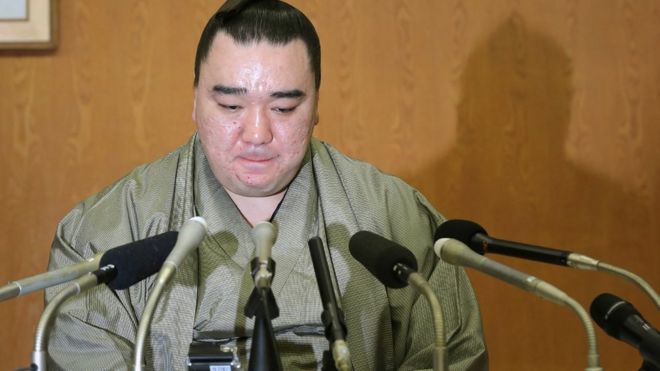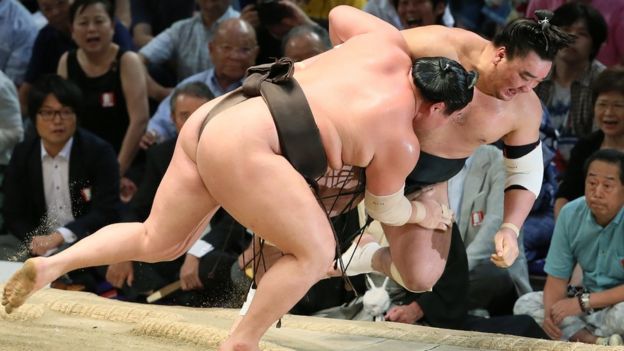Doreen Simmons, Unlikely Voice of Sumo Wrestling, Dies at 85

Doreen Simmons in 2009. A native of England, she moved to Japan in 1973 and became a commentator on sumo wrestling.CreditFrank Zeller/Agence France-Presse — Getty Images
By Richard Sandomir
May 13, 2018
She was born in England, studied theology and classics at the University of Cambridge, and taught school in Singapore.
Yet Doreen Simmons found a remarkably different world to explore — as an expatriate sumo wrestling expert in Japan, analyzing matches in English for NHK, the country’s public broadcaster, for a quarter-century.
She adored sumo, the quintessential Japanese sport. She lived in a part of Tokyo known for its sumo stables where wrestlers live, eat and practice. She loved how they tossed salt in the air before their matches as a purification ritual. She prized the sport’s ancient history and its enormous but surprisingly fast athletes in topknots and loincloths.
“It’s a whole world of its own,” she told the Australian Broadcasting Network in 2016. “Professional sumo is not like anything else. I mean, even sumo wrestling itself is different from almost every other kind because in nearly every other kind you’ll grab your opponent and drag him into yourself, pull him into yourself. Sumo is basically pushing outwards.”
Ms. Simmons, who last worked on television in March, died at home in Tokyo on April 23 at 85, according to St. Alban’s Anglican-Episcopal Church in Tokyo, where she was a congregant. Father William Bulson, the church’s rector, said in an email that the cause was a pulmonary condition.
“The thing about sumo is that it’s so simple,” Ms. Simmons said during a TEDx talk at Meiji University in Tokyo in 2016. “The first time you see it, you know what’s going on. But when you start learning more about it, there are so many extra things, so many details.”
She was teaching at a British army school in Singapore when she read a newspaper article in 1967 about a 13-year-old wrestler — already quite big, agile and talented — who had been recruited to a stable. She was fascinated. She began to read about sumo, an education that was accelerated when she moved to Japan in 1973 to teach at an international language center.
“My original interest was in its survival from the past, but after a while I got to know some of the middle-ranking wrestlers, along with some extremely knowledgeable Japanese fans, who fueled my interest,” she said in 2012 in an interview with Vice, which called her the “godmother” of sumo.
She attended matches on Saturdays, Sundays and holidays, and within a decade her sumo immersion paid off. She started writing for one English-language magazine, Kansai Time Out, and then another, Sumo World. And in 1992, NHK hired her for its English-language sumo broadcasts.
“At the beginning, there were three play-by-play men who had experience of broadcasting games like baseball, but their knowledge of basic sumo was newly acquired and pretty limited,” she said in an interview last year with The Daily Express, a British newspaper. “They wanted the color provided by commentators like me who were hired because we were already knowledgeable about some aspect of sumo.”
Ms. Simmons received the Order of the Rising Sun, one of the Japanese government’s highest honors, last year.
“I have simply never thought of myself in those terms,” she told The Nottingham Post, adding, “I get the feeling that, since most of the Japanese people don’t know anybody who got one of these decorations, they are a way of spreading happiness.”
Doreen Sylvia Clarke was born in Nottingham, England, on May 29, 1932. Her father, George, was a civil servant, and her mother, Elsie (Noble) Clarke, was a store manager who promoted its stationery by running workshops for women on how to make crepe paper flowers. As a child, Doreen, loved singing in her school choir and going to the local library to pick out books suited for each member of her family. “I’d get books on stars, planets, myths, legends, pyramids and dinosaurs,” she said in her TEDx talk.
Her favorite sport while growing up was cricket. She attended local matches, her homemade scorecard in hand. She said that she amassed her knowledge of sumo wrestling with the same devotion she had brought to learning about cricket.
After graduating from Girton College at Cambridge, Ms. Simmons trained as a teacher of Latin and Greek at Hughes Hall, a college at Cambridge, and subsequently left England to teach in Singapore.
Once in Japan, while learning about sumo wrestling, she held other jobs, including one editing translations of Japanese government news releases for the Foreign Press Center and another with the House of Councillors and the House of Representatives, the Japanese legislature. She also did some acting and voice-over work and played the bodhran, an Irish drum, in pubs around Tokyo.
Ms. Simmons left no immediate survivors. Her marriage to Bob Simmons ended in divorce.
Over the years she saw changes in sumo, including its domination by Mongolian wrestlers.
“The Mongolians brought back agile man’s sumo,” she told the Australian network. But, she insisted, foreign wrestlers had not hurt the sport.
“When one of these Mongolians does good sumo and wins,” she said, “the people screaming their heads off are Japanese.”
A version of this article appears in print on May 13, 2018, on Page A22 of the New York edition with the headline: Doreen Simmons, 85, British Expatriate Who Became a Voice of Sumo Wrestling.





 Reply With Quote
Reply With Quote







